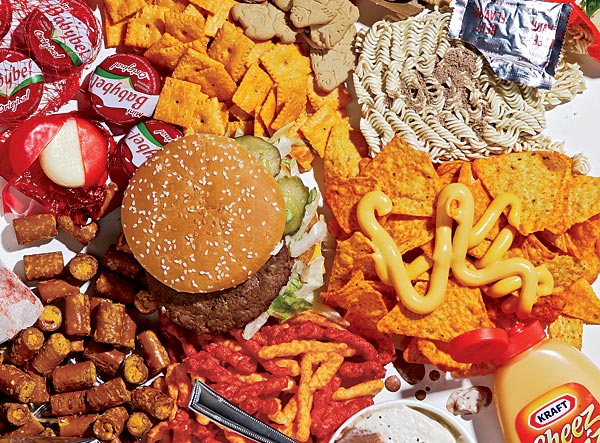 The Most Digusting Ingredients Used In Processed Foods
The Most Digusting Ingredients Used In Processed Foods

Studies have proven that food addiction is the real deal, but if you knew what actually goes into making those yummy processed foods you love so much, you might end up losing your appetite altogether! Here's a list of ingredients commonly found in processed foods throughout the world:
Castoreum
This is just a polite way of saying "extracted from beaver perineal glands." It's used as a natural flavoring and defined by the FDA as any substance extracted, distilled or otherwise derived from 'natural' materials, such as plant or animal matter. Some natural berry flavors may actually be enhanced by castoreum.
Ammonium Sulfate
A salt compound comprised of nitrogen sometimes used to make bread as well as fertilizers. Chemicals with ammonia are typically added to neutralize a food that's too acidic, which can affect texture. While it's relatively safe in the amounts used in foods, the fact that you're eating fertilizer might put off someone from their sandwich.
L-Cysteine
An amino acid made from human hair or duck feathers, often used as a dough conditioner in some bread products to improve the texture and feel as well as prolong their shelf life. The reason is that feathers and hair are readily-available waste products that cost more money to dispose of, and seeing as it's made of protein, they can easily be digested down to amino acids.
Silicon Dioxide
Also known as silica, it's most often present as quartz or sand. Besides the beach, you'll also find in various fast food options. Usually added to foods as an anti-caking agent to prevent clumping.
Titanium Dioxide
A chemical related to the mined metallic element titanium that's commonly found in sunscreen as for its UV light absorbing properties. It also works great as a lightener in foods and is often used to whiten skim milk (which has a bluish tint when the fat is removed). It may also be used in salad dressings, coffee creamers and frosting.
Azodicarbonamide
A processing agent found in plastics products like yoga mats and the soles of your shoes... and hamburger buns.
Shellac
Made from the "secretions from a bug native to Thailand," you'll find it coating your favorite shiny sweets, like jelly beans. Also referred to as "confectioner's glaze" on the ingredients list.
Bone Char
While it's used less and less in foods these days, charred cattle bones was historically used to make sugar appear whiter and more pure. Delicious.
Cellulose
Better known as wood pulp, you'll find it in random foodstuff like shredded cheese, salad dressings, chocolate milk and more. Usually added to foods to keep them from clumping by blocking moisture, and for thickening purposes (since natural ingredients like oil and flour are much pricier to use).
This is just a polite way of saying "extracted from beaver perineal glands." It's used as a natural flavoring and defined by the FDA as any substance extracted, distilled or otherwise derived from 'natural' materials, such as plant or animal matter. Some natural berry flavors may actually be enhanced by castoreum.
Ammonium Sulfate
A salt compound comprised of nitrogen sometimes used to make bread as well as fertilizers. Chemicals with ammonia are typically added to neutralize a food that's too acidic, which can affect texture. While it's relatively safe in the amounts used in foods, the fact that you're eating fertilizer might put off someone from their sandwich.
L-Cysteine
An amino acid made from human hair or duck feathers, often used as a dough conditioner in some bread products to improve the texture and feel as well as prolong their shelf life. The reason is that feathers and hair are readily-available waste products that cost more money to dispose of, and seeing as it's made of protein, they can easily be digested down to amino acids.
Silicon Dioxide
Also known as silica, it's most often present as quartz or sand. Besides the beach, you'll also find in various fast food options. Usually added to foods as an anti-caking agent to prevent clumping.
Titanium Dioxide
A chemical related to the mined metallic element titanium that's commonly found in sunscreen as for its UV light absorbing properties. It also works great as a lightener in foods and is often used to whiten skim milk (which has a bluish tint when the fat is removed). It may also be used in salad dressings, coffee creamers and frosting.
Azodicarbonamide
A processing agent found in plastics products like yoga mats and the soles of your shoes... and hamburger buns.
Shellac
Made from the "secretions from a bug native to Thailand," you'll find it coating your favorite shiny sweets, like jelly beans. Also referred to as "confectioner's glaze" on the ingredients list.
Bone Char
While it's used less and less in foods these days, charred cattle bones was historically used to make sugar appear whiter and more pure. Delicious.
Cellulose
Better known as wood pulp, you'll find it in random foodstuff like shredded cheese, salad dressings, chocolate milk and more. Usually added to foods to keep them from clumping by blocking moisture, and for thickening purposes (since natural ingredients like oil and flour are much pricier to use).










